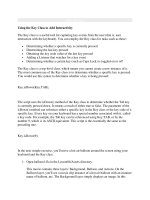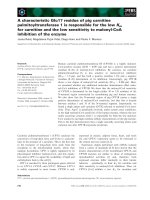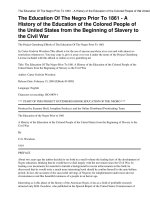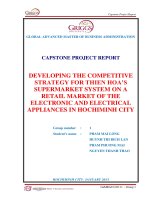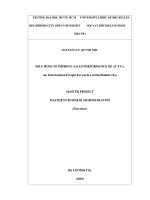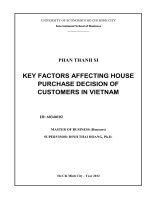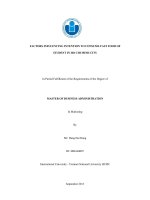The key loyalty to usage internet banking of individuals in hochiminh city, vietnam
Bạn đang xem bản rút gọn của tài liệu. Xem và tải ngay bản đầy đủ của tài liệu tại đây (870.7 KB, 74 trang )
THE KEY LOYALTY TO USAGE OF INTERNET BANKING
OF INDIVIDUALS IN HOCHIMINH CITY, VIETNAM
In Partial Fulfillment of the Requirements of the Degree of
MASTER OF BUSINESS ADMINISTRATION
In International Business
By
Ms: Võ Thị Diệu Hiền
ID: MBA03011
International University - Vietnam National University HCMC
March 2013
THE KEY ANTECEDENTS TO USAGE OF INTERNET BANKING
OF INDIVIDUALS IN HOCHIMINH CITY, VIETNAM
In Partial Fulfillment of the Requirements of the Degree of
MASTER OF BUSINESS ADMINISTRATION
In International Business
by
Ms: Võ Thị Diệu Hiền
ID: MBA03011
International University - Vietnam National University HCMC
March 2013
Under the guidance and approval of the committee, and approved by all its members, this
thesis has been accepted in partial fulfillment of the requirements for the degree.
Approved:
---------------------------------------------Chairperson
--------------------------------------------Committee member
---------------------------------------------Committee member
--------------------------------------------Committee member
---------------------------------------------Committee member
--------------------------------------------Committee member
Acknowledge
To complete this thesis, I have been benefited much from Doctor Lê Nguyễn Hậu-the
advisor. So, I would like to express many thanks to him for guiding us months from months
of hard working on my thesis.
From the bottom of my heart, I wish to express sincere appreciation to Doctor Nguyễn
Quỳnh Mai-the faculty dean, and Master Nguyễn Văn Tuấn-the SPSS tutor. These teachers
have lightened up our mind and supported us with their knowledge and enthusiasm.
Besides, I am very grateful to respondents for their feed-back. Thanks to input data
they contributed I can complete this thesis today.
-i-
- ii -
Plagiarism Statements
I would like to declare that, apart from the acknowledged references, this thesis either
does not use language, ideas, or other original material from anyone; or has not been
previously submitted to any other educational and research programs or institutions. I fully
understand that any writings in this thesis contradicted to the above statement will
automatically lead to the rejection from the MBA program at the International University –
Vietnam National University Hochiminh City.
- ii -
Copyright Statement
This copy of the thesis has been supplied on condition that anyone who consults it is
understood to recognize that its copyright rests with its author and that no quotation from the
thesis and no information derived from it may be published without the author‟s prior consent.
© Võ Thị Diệu Hiền/ MBA03011/2010-2013
- iii -
Table of Contents
List of Tables ...................................................................................................................... vi
List of Figures .................................................................................................................... vii
Abstract.............................................................................................................................. viii
Chapter one: Introduction .................................................................................................1
1.1.Research background ............................................................................................1
1.2.Thesis Topic ............................................................................................................3
1.3.Rational ....................................................................................................................3
1.4.Problems ..................................................................................................................3
1.5.Research question...................................................................................................4
1.6.Research objective ..................................................................................................4
1.7.Significant of the research.....................................................................................5
1.8.Research method ....................................................................................................5
1.9.Scope of study .........................................................................................................5
Chapter two: Literature review and Frame work ...........................................................6
2.1.Literature review .....................................................................................................6
2.1.1.Internet banking ..................................................................................................6
2.1.2.TAM, TRA, TPB ................................................................................................6
2.1.3.Perceived Usefulness (PU) ................................................................................9
2.1.4.Perceived Ease of Use (PEOU) .......................................................................9
2.1.5. Perceived risk (PR) ......................................................................................... 10
2.1.5.1.Financial risk (FR) ......................................................................................... 11
2.1.5.2.Privacy risk (PR) ............................................................................................ 11
2.1.6.Cost of price (COP)......................................................................................... 12
2.1.7.Usage Intention (UI) ....................................................................................... 13
2.2.Theoretical framework ....................................................................................... 13
Chapter three: Research Methodology ......................................................................... 15
3.1.Introduction ......................................................................................................... 15
3.2.Sampling and data collection............................................................................. 16
3.2.1.Sampling approach .......................................................................................... 16
3.2.2.Data source ....................................................................................................... 16
3.2.3.Data collection .................................................................................................. 16
3.2.4.Measurement development ............................................................................ 17
Chapter four: Data analysis and result .......................................................................... 22
4.1.Sample demographics ......................................................................................... 22
4.2.Result ..................................................................................................................... 23
4.2.1.Analysis of measurement model ................................................................... 23
4.2.2.Exploratory Factor Analysis (EFA) .............................................................. 26
4.2.3.Reliabitity for groups of PEOU and PRC................................................... 30
4.2.4.Correlation between variables........................................................................ 30
4.2.5.Adjusted model after EFA ............................................................................. 31
4.3.Hypothesis restating............................................................................................ 31
4.4.Hypothesis testing ............................................................................................... 32
4.5.Multicollinearity ................................................................................................... 33
4.6.The equation ........................................................................................................ 33
4.7.Descriptive statistics ........................................................................................... 34
4.8.ANOVA test ........................................................................................................ 37
- iv -
4.9.Achievement in predictive purpose ................................................................. 40
Chapter five: Discussion and recommendations ........................................................ 41
Chapter six: Conclusion and limitations ....................................................................... 44
Refferences......................................................................................................................... 46
Appendix A: Questionnaire (English) .......................................................................... 49
Appendix B: Questionnaire (Vietnamese) ................................................................... 52
Appendix C: Reliability Statistics and Item-total statistics. ....................................... 55
Appendix D: Reliability Statistics and Item-total statistics after EFA. ................... 57
Appendix E: Measurement Scale and Sources. ........................................................... 60
-v-
List of Tables
Table 1. Dimensions of perceived risk.
Table 2. Independent variables (indicators)
Table 3. Cronbach's Alpha before EFA
Table 4. KMO and Bartlett's Test
Table 5. KMO and Bartlett's Test after rejecting PEOU1 and PR3
Table 6. Factor loading
Table 7. Total variance explained
Table 8. Representative variables
Table 9. Correlations
Table 10. Coefficients
Table 11. Descriptive statistics of variables
Table 12. Test of Homogeneity of Variances (experience)
Table 13. ANOVA (experience)
Table 14. Multiple comparisons
Table 15. Test of Homogeneity of Variances (Education)
Table 16. ANOVA (Education)
Table 17. Multiple comparisons
Table 18. Test of Homogeneity of Variances (Job)
Table 19. ANOVA (Job)
Table 20. Multiple comparisons
Table 21. Model summary
- vi -
List of Figures
Figure 1. The propose model for key determinants of internet-banking usage.
Figure 2. Male and Female distributions in the sample size.
Figure 3. Education distribution in the sample size
Figure 4. The adjusted model for key determinants of internet-banking usage
- vii -
Abstract
Purpose - The aim of this research is to explore key antecedents that affect the
customer usage intention of internet banking service in Hochiminh city of Vietnam.
Design/methodology/approach - A quantitative research was applied with survey
questionnaire dispatched to 470 respondents at bank counter and via email also. Prior to the
official survey, a pilot test in 10 respondents who had been used internet banking more than
three years and bank staffs. A number of 194 usable responses were used as input data.
Findings – The results indicate that the customers‟ usage intention was affected
mostly by the perceived usefulness characteristics and the perceived ease of use secondly.
The findings suggest that banks should have specific plans to develop services and related
facilities, including software or machinery.
Research limitation – The result only aims to Hochiminh city customers only, and
with limitation of respondents, it may bias. Moreover, the indicators of financial risk were
still limited in two. So, it may not enough information for customer to give out their real view
of point.
Managerial implication – The research points out that although perceived risk had not
effected to usage intention of users, banks still need much care on this issue to prevent
negative affection from users. Besides, as perceived usefulness got highest score in adoption
of customers‟ usage of internet banking, the service providers develop more utilities and
extend the services.
Keywords: internet banking, usage intention, TAM
- viii -
- ix -
Chapter One - Introduction
1.1.
Research background
Internet and information technology (IT) are antecedents for the development
of numerous industries of which banking industry represents the most. Thanks to the
revolution of internet, banks have facilitated and offered to customers numerous
novel services. Electronic banking or e-banking speaks of this. E-banking is services
based on a high banking technology that could process information online. E-banking
includes services of ATM cards, online banking, SMS banking and phone banking.
Bank‟s users (or clients) can stay at home or at their office or at any place while
doing banking transactions on their own without the bank teller.
E-Banking supplies customers with internet banking, SMS-Banking, Phone
Banking, e-token and other forthcoming services.
Electronic banking includes internet-banking which based on internet
applications. Pikkarainen, Karjaluoto, and Pahnila, (2004) define internet-banking as
an internet portal, „through which customers can use different kinds of banking
services ranging from bill payment to making investments‟.
According to Ranjit (2012), current internet banking websites can be
classified into four levels: entry, basic, intermediate and advanced. At entry level,
only general information as an image of the bank is presented with general
production and company news. Second level adds some additional basic interactive
tools and some origination capabilities. Next comes with more interesting level
where customers can access their account, track and view account information.
Finally the advanced level serves complete internet banking functionality and
security. At this stage, customers can do themselves the banking transaction at home
by transferring their money to and from account(s), paying internet bills, electronic
-1-
and water bills, insurance premium bills, etc., paying credit card statement balance,
transfer money to electronic wallet, virtual accounts. Recently, one novel function
has been added to internet-banking services is online saving account opening.
SMS banking is a service where customers use their mobile phone as a mean
of receiving and/or sending their order via Short Message Service protocol to the
bank system. SMS banking responses requirement of account statement, current
account balance, credit balance, foreign exchange rate, account balance report, and
many other inquiries etc.
Phone banking uses the same mean of SMS banking, that is to say customers‟
cell phone as a way to ask for services from banks. With customers‟ phone, they call
to the bank switchboard and inquire for account balance, and other card service
performance.
Banks employ internet as an alternative service delivery channel to traditional
ones such as face-to-face and telephone banking in providing customers with a
varieties of services. The boost of new technology leads the new trend of utilization
of banking service. According to a survey in 2011, the American Banker Association
found that 62 percent of American bank customers preferred online banking to other
methods, up from 36 percent of year 2010. Only 20 percent of respondents said they
preferred using bank branches.
In Vietnam, the number of internet users increases tremendously within
nearly nine years, that is to say 901.77% from the year 2003 (statistically called for
3,098,007 users; users per capita is 3.8%) to June 2012 (31,034,900 users; users per
capita is 35.4%) (as stated in ). This clearly indicates
the significance of online banking sector towards Vietnamese banks, and why the
banks have been well invested in infrastructure for the kind of services in recent years.
-2-
Hence, in the present research we considered the customers‟ intention of
utilization of internet-banking in Vietnam in good condition of internet and in the
availability and readiness of the service providers.
1.2. Thesis Topic
The key loyalty to usage of Internet-banking of individuals in Hochiminh
city, Vietnam.
1.3. Rationale
Vietnam is a developing country. Among the national development targets,
information technology is a priority. Thanks to that domestic banks now have
chances to innovate their services based on high technology. As information
technology develops, novel ways of banking transaction become an indispensable
trend. Online banking day-by day becomes familiar to most of us. However, the
number of users remains not as high as being expected. Therefore, the purpose of this
research is to study the impact of variables to the acceptance of customers for
internet-banking services.
1.4. Problems
Today banks provide electronic banking (e-banking) to customers with
plentiful methods, such as internet banking, phone-banking, SMS banking, ATM
cards, etc.,. Nonetheless the amount of users does not reach as high as expected. We
can take Hochiminh city e-banking users for instance. As for the non-cash payment,
based on statistics of 15 commercial banks in Hochiminh city there were nearly
112,000 customers using payment services via e-banking systems with total
-3-
transaction value of more than VND49 trillion in 2011, according to Nguyen Van
Dung, deputy director of the Hochiminh city branch of the State Bank of Vietnam
(SBV) (Van Oanh, 2012). Counting up the Hochiminh city population of over eight
million persons in 2012 (statistical population in 2010 is 7.4 million persons), that
amount of users is quite few.
Besides, mobile payment is also a concern. There are over 100 million mobile
phone subscribers in the country counting for the Viettel brand name only (regardless
of Mobifone and Vinafone), and around 20 million bank account users. However,
these customers are just a great potential source, according to Nguyen Viet Dung,
deputy director of Viettel telecom company (Van Oanh, 2012). In addition to Viettel,
Mobifone and Vinafone are two more giants of mobile telecommunication providers.
The number of subscribers is really a mine of gold. The market turns out an attractive
pie for banks with phone-banking services. In actual fact the account holders do not
pay much attention to phone-banking, or maybe they even ignore the services.
1.5. Research Question
The study addresses two following research questions:
1/What are the key antecedents of customers‟ acceptance of internet-banking?
2/What should banks do to entice customers to internet-banking services?
1.6. Research Objective
The objective of this study is to examine key loyalty of usage of internetbanking in individuals of Hochiminh city banking users.
-4-
1.7. Significance of this Research
The research contributes value both to the bank users and to the banks. First,
e-commerce providers can adjust the activities to boost their business thanks to the
analysis of customers‟ acceptance and the recommendation of the research. Second,
financial institutions can manipulate online services as a simultaneous channel of
earning money. Finally bank users have an additional way to enjoy the bank facilities.
1.8. Research Method
This research applied deductive approach, using the literature review as base
to build up model and develop hypotheses. In additions to that, empirical data
withdrawn from usable survey questionnaires were used to test the treaties. To
perform the statistical tests, we used two key techniques: Exploratory Factor Analysis
and Multiple Regression. The SPSS was to analyze data. The theoretical models
employed to study user acceptance, adoption include the Theory of Reason Action
(TRA) (e.g. Fishbein and Ajzen, 1975; Aizen and Fishbein, 1980), and the
Technology Acceptance Model (TAM).
1.9. Scope of Study
This study was conducted in Hochiminh city, the most dynamic city in
southern area of Vietnam. E-banking is quite a broad field, so in this research we just
focus on one of its areas that calls internet-banking.
-5-
Chapter Two – Literature Review and Frame Work/ Model
2.1. Literature review
2.1.1. Internet banking
According to Pikkarainen, Karjaluoto, and Pahnila, (2004) Internet banking is
defined as an “internet portal, though which customers can use different kinds of
banking services ranging from bill payment to making investments”. Internet banking
provides bank customers access to almost any type of banking transaction at a click
of a mouse, except for the cash withdrawal (De Young, 2001; Nupur, 2010). Thanks
to internet banking, financial services have an alternative channel to get close to the
users.
The internet banking dedicates benefits to both the supplier and the consumer
of the services. As the supplier, banks use online banking as it is one of the cheapest
delivery channels for banking products (Pikkarainen et al., 2004). Such services also
save the time and money of the bank with an added benefit of minimizing the
likelihood of committing errors by bank tellers (Jayawardhena & Foley, 2000). On
the other side, users gain from having alternative choice to consume the bank service.
Now that some customers who felt branch banking that took too much time and effort
can make use of internet banking to make transactions at a click of their fingers
(Nupur, 2010). The user can also save time doing transaction on online as “banking is
no longer bound to time and geography. Customers over the world have relatively
easy access to their accounts, 24 hours per day, and seven days a week” (Karjaluoto
et al., 2002).
2.1.2. TAM, TRA, TPB
Internet banking adoption has been a subject for researchers to involve in for
many decades ago. The scholars have tried to figure out the factors that most impact
-6-
users‟ intention to accept the online service. They successfully studied the
individual‟s adoption of Internet banking by applying theories, together with its
variables (or factors). The utmost theories are Technology Acceptance Model (TAM),
Theory of Reasoned Action (TRA), and Theory of Planned Behavior (TPB). The first
model, TAM was used in the researches of Davis et al in 1989. The second one, TRA
originally proposed by Fishbein and Ajzen (1975) (Gefen et al, 2003) while the TPB
originally proposed by Ajzen (1991) (Shih and Fang, 2004).
The Theory of Reasoned Action (TRA), developed by Fishbein and Ajzen
(1975), was probably one of the most influential theories used to explain human
behavior (Venkatesh et al, 2003). According to TRA, the behavioral intention can be
explain by the attitude towards behavior and subjective norm. The attitude towards
behavior posits the individual‟s feeling of negative or positive about performing the
target behavior (Fisher and Ajzen, 1975). Subjective norm relates to perception that
most people who really matter to the individual think that he/she either should or
should not perform the behavior in question (Fisher and Ajzen, 1975).
The theory of Planned Behavior (TPB) was suggested by Ajzen (1991). It
extends TRA (Fisher and Ajzen, 1975) as for case of people who have incomplete
volitional control. This proposes that a central factor in human behavior is behavioral
intention, which is affected by attitude toward behavior, subjective norm, and
perceived behavioral control (Ajzen, 1991). This theory shows how people
acknowledge the internal and external limitations to their behavior. It refers to how
people believe it would be to perform certain behaviors (Ajzen, 1985).
The Technical Acceptance Model (TAM) (Davis, 1989; Davis et al, 1989)
was adapted from the Theory of Reasoned Action (TRA) (Fishbein & Ajzen, 1975;
Ajzen & Fishbein, 1980) to understand the causal chain linking external variables to
-7-
technology usage intention and actual use in a work place (Ndubisi and Jantan, 2003).
TAM posits that user adoption of a new is determined by the user‟s belief about the
system. TAM further suggests that the two beliefs - perceived usefulness and
perceived ease of use – are instrumental in explaining the variance in the intention of
users (Wang, Lin and Luarn, 2006). These two beliefs have been empirically justified
as important factors determining the adoption and use of new information technology,
including the adoption of Internet banking (Vijayyasarathy, 2004).
As an inheriting model from TRA, TAM shares some issues with the previous
theory. However the two models still comprise some significant differences. One is
that according to TRA all beliefs are bound to context and hence they cannot be
generalized. Conversely, TAM states that Perceived Usefulness and Perceived Ease
of Use are issues that have an effect on acceptance of all information system. Another
utmost distinction is that in TRA all beliefs are summed together, whereas in TAM
both beliefs are seen as separate constructs.
TAM has been tested in many previous studies and been demonstrated its
ability to explain the attitude toward using an information system better than other
models (TRA and TPB) (Mathieson, 1991). Moreover, TAM is chosen to be the
research model owing to two main reasons (Guriting and Ndubisi, 2006). Firstly, it
helps to understand the relationship between users‟ perception of the benefits and the
usability of their system(s) (Ndubisi and Jantan, 2003). Secondly, TAM is acclaimed
for its parsimony and predictive power which make it easy to apply in different
situation (Ndubisi and Jantan, 2003; Venkatesh and Morris, 2000).
In this research we use the modified version of TAM to justify the customers‟
usage intention of internet banking. In other words, the practical TAM model would
be added up three more other factors together with the two basic ones, Perceived
-8-
Usefulness and Perceived Ease of Use. The additional factors are Financial Risks,
Privacy Risks, and Cost of Price.
2.1.3. Perceived Usefulness (PU)
According to Davis (1989), Perceived Usefulness defines as a degree to which
an individual perceives a particular system enhancing his or her job performance. Lee
(2008) also added that as Perceived Usefulness reflects the person‟s salient belief in
the use of technology, it will be helpful in improving performance. Hanudin (2007)
confirmed that there is significant effect of Perceived Usefulness on usage intention.
Customers would choose online banking when they acknowledge the positive
contribution of this kind of service. Hence, we propose the hypothesis as follows:
H1: Perceived Usefulness has positive impact on intention of internetbanking usage
2.1.4. Perceived Ease of Use (PEOU)
Perceived Ease of Use is a degree to which an individual believes that using a
particular system would be free of effort (Davis, 1989; Taylor and Toadd, 1995;
Hanudin, 2007). Previous researches have come to the conclusion that there are
significant effects of Perceived Ease of Use on usage intention, either directly or
indirectly through its effect on Perceived Usefulness (Venkatesh, 2000; Venkatesh
and Morris, 2000; Agarwal and Prasad, 1999, Davis et al., 1989). It comes to our
work the under mentioned hypothesis:
H2: Perceived Ease of use has positive impact on intention of internetbanking usage
-9-
2.1.5. Perceived Risk (PCR)
Perceived Risk theory has been used to explain consumers‟ behaviors since
the 1960s (Lee, 2008). It has definite impact on consumer decision making (Lin,
2008). Bauer (1960) defined risk in terms of uncertainty and consequences associated
with consumers‟ actions. Cunningham (1967) noted that perceived risk consisted of
the size of potential loss if the results of the act were not favorable and the
individual‟s subjective feelings of certainty that the results will not favorable. Peter
and Ryan (1976) described perceived risk as the possible loss when pursuing a
desired result. According Clow (1998), customers receive greater risks when buying
services than tangible goods. In addition, Zeitheml (1981) suggested that services
riskier than goods because it is intangible, non-standardized, and often sold without
guarantees. Perceived risk was claimed by many scholars to be a multi-dimensional
construct, which are: financial, performance, social, physical, privacy, and time-loss
(Jacoby and Kaplan, 1972; Kaplan et al., 1974; Roselius, 1971). Nevertheless, it
depends on the service or the product that accompanies the dimensions of perceived
risk. Internet banking service in this research mainly focuses on financial risk and
privacy risk.
Table 1. Dimensions of perceived risk.
Dimension
Definition
Financial risk
The probability that a banking transaction results in loss of money
due to transaction error or bank account misuse.
Privacy risk
Potential loss of control over personal information, such as when
information about the user is used without his/her acknowledge or
permission. This commonly happens with fraudulent attack.
- 10 -
2.1.5.1. Financial Risk (FR)
Financial risk is defined as the potential loss of money due to
transaction error or bank account misuse. This is the second most important
factor to prevent the adoption of online banking (Lee, 2009) and has been
proven as one of the key concern in e-service adoption (Feathernam & Pavlou,
2003). Failure transaction may take money away from the users. In fact, many
customers are scared of losing money while performing transaction or
transferring money over the internet (Kuisma et al, 2007). As a result it
discourages users to accept internet banking. Thus, we will test the following
hypothesis:
H3: Financial Risk has negative impact on intention of internet-banking
usage
2.1.5.2. Privacy Risk (PR)
Privacy risk is described as a potential loss resulting from fraud or a
hacker who attacks the security of an online bank user (Lee, 2008). The
customer‟s loss may also come from phishing. The phisher try to obtain
financial or other confidential information such as username, password, credit
card number, and even OTP number from internet user, typically by sending
out legitimate-looking emails. These emails contain a link to a fake website
that replicates the real one. Both fraud and hacker intrusion not only lead to
monetary loss, but also violate users‟ privacy, a major concern of many
- 11 -
internet users. Criminals aim on stealing users‟ online banking credentials as
the user name and password combination is somehow easy to acquire and then
relatively easy to fraudulently access an internet banking account and commit
financial fraud (Nupur, 2010). Pikkarainen et al. (2004) proved that privacy
risk significantly impacts on online banking and e-service adoption. That is the
reason why we should consider this hypothesis:
H4: Perceived Risk has a negative impact on intention of internetbanking usage
2.1.6. Cost of Price (COP)
Cost of Price is the banking fee that the customers have to pay for
internet-banking services. The users were significant satisfied with the cost
saving amount through electronic banking (Polatoglu and Ekin, 2001). Low
fees, time savings and freedom from time and place (Karjaluto et al., 2002a)
have been found to be the most important elements of internet banking.
However, researchers also suggested that consumers perceive electronic
banking as inexpensive and that it does not offer extra cost benefits
(Karjaluoto et al., 2002; Gerrard and Cunningham, 2003). Regardless of
conflicting finding, Sathye (1999) assured that the cost associated with
electronic banking, such as the cost of electronic banking activities and bank
charges, had a negative impact on internet-banking usage. Under those
circumstances, the following hypothesis needs to be tested:
H5: COP has negative impact on intention of internet-banking usage
- 12 -
